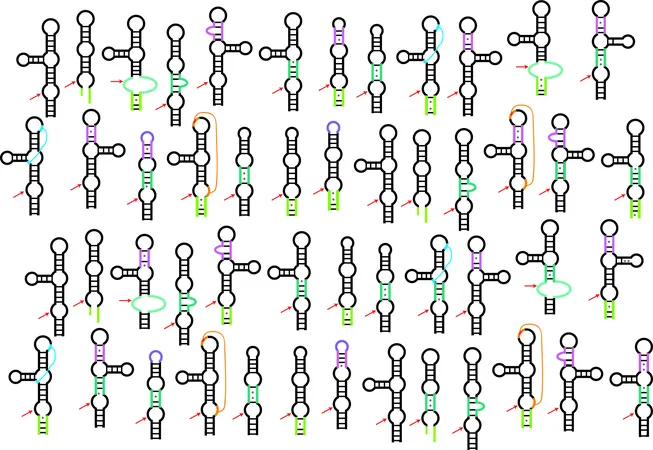
Revolutionary Discovery: First 'Twister Ribozyme' in Mammals Found Through Groundbreaking RNA Research!
2024-11-05
Author: Jacob
Introduction
The scientific community has long been fascinated by the "RNA world" hypothesis, which suggests that early life on Earth may have thrived primarily on RNA—a molecule similar to DNA but with the versatile ability to act both as a genetic carrier and as a catalyst for biochemical reactions. While a select few RNA enzymes, known as ribozymes, have been actively studied, a plethora more have been computationally predicted to exist across various organisms, from simple bacteria to complex mammals.
Innovative Methodology
A team of researchers from Penn State has developed a pioneering method that allows scientists to evaluate the activity of thousands of RNA sequences—an accomplishment that could lead to significant breakthroughs in our understanding of ribozymes. In their recent study, the team tested over 2,600 different RNA sequences identified as members of the "twister ribozymes" class. These enzymes are distinguished by their unusual ability to cleave themselves into two parts. Astonishingly, approximately 94% of the examined ribozymes exhibited activity, and the findings further revealed that these enzymes remain functional even when faced with minor structural irregularities.
Key Discovery
Notably, the researchers discovered the first twister ribozyme in a mammal: the bottlenose dolphin. This finding not only expands our understanding of ribozyme diversity but also hints at intriguing evolutionary adaptations in marine mammals.
Significance of Structural Configurations
The study, published in the journal *Nucleic Acids Research,* sheds light on the complex structures that RNA can form, such as loops and bulges, significantly impacting the functionality of these enzymes. Phil Bevilacqua, a distinguished professor at Penn State and leader of the research team, emphasized the importance of the structural configurations in determining ribozyme activity, stating, "These structures play a critical role in how RNA enzymes function."
Empirical Validation of Theoretical Predictions
Prior to this innovative study, around 1,600 twister ribozymes had been theorized based on genomic data, but empirical validation was scarce. This team turned the tide with a novel approach named the "Cleavage High-Throughput Assay" (CHiTA), which enables simultaneous testing of numerous ribozyme candidates in a single experiment.
Technological Advances
CHiTA utilized cutting-edge technology, specifically massively parallel oligonucleotide synthesis (MPOS), which allows researchers to design a vast array of ribozyme sequences efficiently. By coupling this with a powerful technique that helps fine-tune ribozyme sequences—manipulating their DNA to remove unnecessary additions—the team achieved remarkable clarity in assessing ribozyme functions.
Implications for Future Research
In their laboratory, after synthesizing RNA from the optimized DNA sequences, researchers found that many ribozymes still cleaved correctly despite possessing minor imperfections. This significant tolerance to defects suggests a broader diversity of functional ribozymes in nature—potentially more than previously recognized.
Concluding Remarks
As the implications of this research unfold, Bevilacqua noted that enhancing our understanding of ribozyme behavior could lead to innovative methods for identifying new ribozymes and unraveling their biological significance. This expanded knowledge could even provide clues about life’s origins on Earth and the role RNA played during the planet's formative years.
The Penn State team, which included skilled graduate researchers and bioinformatics specialists, is hopeful that their findings will foster new explorations in synthetic biology and biotechnology, paving the way for understanding life's early mechanisms and possibly altering future avenues in genetic research.
Future Prospects
Stay tuned as more discoveries arise in the ongoing quest to decode the mysteries of RNA and its crucial contributions to life as we know it!









 Brasil (PT)
Brasil (PT)
 Canada (EN)
Canada (EN)
 Chile (ES)
Chile (ES)
 España (ES)
España (ES)
 France (FR)
France (FR)
 Hong Kong (EN)
Hong Kong (EN)
 Italia (IT)
Italia (IT)
 日本 (JA)
日本 (JA)
 Magyarország (HU)
Magyarország (HU)
 Norge (NO)
Norge (NO)
 Polska (PL)
Polska (PL)
 Schweiz (DE)
Schweiz (DE)
 Singapore (EN)
Singapore (EN)
 Sverige (SV)
Sverige (SV)
 Suomi (FI)
Suomi (FI)
 Türkiye (TR)
Türkiye (TR)